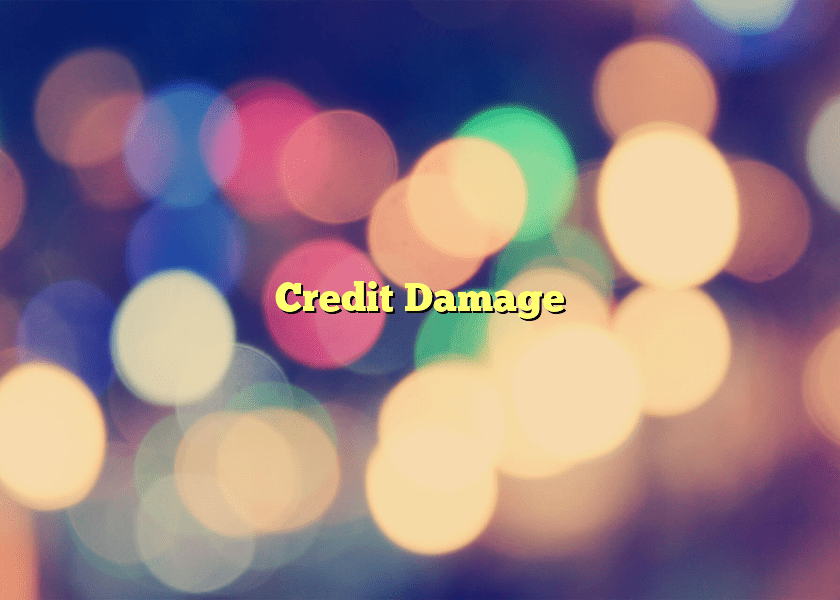Credit Damage
Until recently lawyers for victims of credit damage had little possibility to collect for damages beyond medical treatment, lost wages and property loss. Insurance companies threw up their hands in sympathy, claiming victims can only be compensated for what can be measured — tangible goods and services. But, what happens when the victim has lost considerable time from work, the family bank is broke and monthly payments on mortgages, car loans and credit cards payments are missed? Regardless of the haggling between lawyers and insurance companies, it’s the credit victim who ends up having to live with a bad credit rating.
Today, there are legally accepted means for measuring loss of credit through the procedure of Credit Damage Measurement (CDM). CDM is fast becoming a potent tool for recoverable credit damage awards when the damage is not self-inflicted. Previously, both judge and jury, and especially the insurance companies, refused to acknowledge CDM claiming it was speculative because they could not define it as tangible damage. However, in case after case, victims of credit damage who use the CDM method are getting compensation for credit loss. Many factors are changing the old mindset including credit bureau technology improvements, the application of the Fair Credit Reporting Act (FCRA), risk scoring sophistication, and the development of CDM as an objective, repeatable method that measures out-of-pocket damage reliably.
Credit Ratings and Recovery
The impact of a bad credit rating is much more significant than most people think. Consider what poorly rated consumers face when they want to lease or buy vehicles, obtain credit cards, buy or lease or refinance their residence. In most cases, it’s an easy decision for the creditor: the credit application is simply turned down or the borrower is charged a much higher down payment – maybe thousands of dollars more with monthly payments that are typically several hundred dollars more.
“A person with bad credit is viewed with suspicion and is charged significantly more for future extension of credit because the lender feels the need to protect against a greater risk or default,” says Tom Key, a civil litigator practicing in Tustin, CA.
“Over the years I have heard reports of financial damages from clients who have been wrongfully terminated, defrauded, injured in an accident or suffered losses from breach of contract,” Key says. “These victims were especially distraught over the fact that their prime credit reputation, carefully nurtured for years, is destroyed overnight. It seemed to me that there must be a way to compensate victims for that type of loss.”
Key has witnessed the reactions of many jurors who failed to award a victim of credit damage their rightful compensation simply because they could not quantify the damages. “Jurors want a specific loss that they can count, hold and see,” says Key. “Their reasoning is that they need to know that it is genuine. They have a tough time awarding damages based on sympathy. In order for them to confirm authenticity of a claim, they want to see its quantification.”
Measuring Loss of Creditworthiness
Assuring authenticity has been a sticky situation when it concerns measuring out-of-pocket loss for victims of credit damage — until now. Attorneys who represent victims of credit damage are now utilizing the Credit Damage Measurement method to recover out-of-pocket losses for their clients. “CDM measures the actual out-of-pocket dollars reasonably expected from loss of creditworthiness, which includes higher down payments, higher points and costs on loans, higher interest rates, higher monthly payments, or outright denial of credit,” says Key. “In addition, the CDM method also calculates the rates, costs and other terms applicable to the resulting credit rating by lenders and projects the results over the relevant number of years for the types of loans the client is likely to seek.”
Key continues, “For example, if a client’s credit was near perfect before a triggering event, and is subsequently damaged by the event, the CDM procedure can illustrate before and after analyses, calculating the cost of the same loans with the two different credit reports, Pre- injury credit compared to Post-injury credit.” In many cases, CDM clients have already realized significant compensation. In one such case CDM was instrumental in recovering $56,000 for damaged credit reputation. “That calculation is the difference between what refinancing a $140,000 loan would have cost my client with their prior rating, and what it will cost them out-of-pocket with their damaged credit rating —measured over a seven-year period.”
Isolated Compensation vs. Repeatable Compensation
The CDM method of measuring intangible credit loss is increasingly becoming the basis of recovery for victims of credit damage. It’s changing the way judges and juries measure recoverable out-of-pocket loss, and then can compensate for loss of credit expectancy. Certainly there are still some skeptics, mostly defendants. Technically, credit damage measurement is intangible. However, CDM has proven an objective and practical procedure to calculate out-of-pocket damage for companies or families to compensate for their credit damage.
“To have this kind of measurement is an exciting complexity in our society,” says Key. “CDM is very understandable and a rather simple way to come to a conclusion of loss for the victim. If you understand the math and are an expert at reading credit reports, the calculations and recovery are undeniable. It’s a method of turning isolated compensation into repeatable compensation. It’s changing the way jurors rule on these damaging cases. Because of this method, victims of credit damage can be more fairly and more completely compensated for out-of-pocket damage.”
